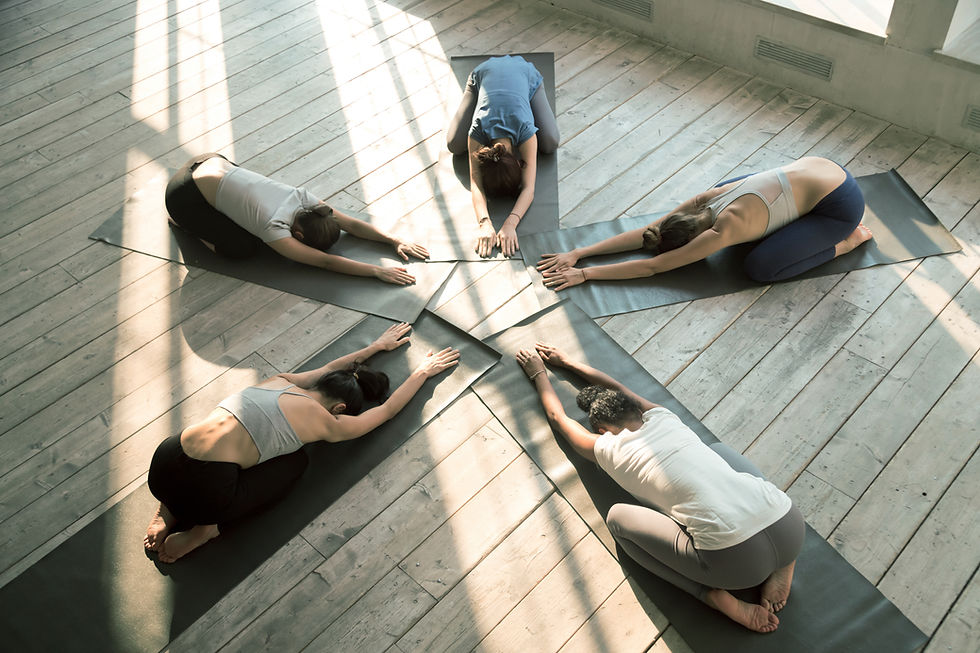Restorative Yoga for Sports Injuries: Gentle Healing for Body and Mind
- msuttmeyer
- 10 hours ago
- 2 min read

Introduction
Physical activity is an essential part of a healthy lifestyle. However, despite all precautions, injuries can occur. In such cases, a holistic approach to rehabilitation is crucial. This is where restorative yoga comes in—a gentle practice that not only heals the body but also calms the mind.
What is Restorative Yoga?
Restorative yoga is a form of yoga that focuses on deep relaxation and healing. Unlike dynamic yoga styles, postures (asanas) are held for extended periods of time and supported with props such as pillows, blankets, and blocks. This allows the body to fully relax and activate the parasympathetic nervous system—the part of the nervous system responsible for rest and recovery.
The role of restorative yoga in rehabilitation
1. Promote healing through relaxation
After an injury, it's important to give your body sufficient rest. Restorative yoga offers a way to relax the body in a safe and supported environment. Studies have shown that deep relaxation promotes healing and can reduce pain.
2. Improve mobility
Many sports injuries result in limited mobility. Through gentle stretches and supported postures, restorative yoga can help restore flexibility and increase range of motion.
3. Strengthening body awareness
Increased body awareness is crucial for identifying poor posture and unhealthy movement patterns that can lead to injury. Restorative yoga promotes this awareness through mindful movement and breathing techniques.
4. Support of the nervous system
Injuries can trigger stress and anxiety. Restorative yoga helps calm the nervous system and reduce emotional stress, supporting the healing process.
Scientific findings
Research has shown that yoga, including restorative yoga, is an effective method for supporting the rehabilitation of sports injuries. One study found that yoga improves flexibility, muscle strength, and stability while reducing pain. Yoga has also been found to increase psychological resilience and promote recovery.
Practical application of restorative yoga
Suitable postures for rehabilitation
Some restorative yoga poses that are particularly beneficial for sports injuries:
Supported Child's Pose (Balasana): Gently stretches the back and hips.
Supported Shoulder Stand (Salamba Sarvangasana): Promotes blood circulation and calms the nervous system.
Supported Downward-Facing Dog (Adho Mukha Svanasana): Stretches the legs and strengthens the arms.
Supported Twist Pose (Supta Matsyendrasana): Improves spinal flexibility.
Integration into everyday life
To effectively integrate Restorative Yoga into your daily routine:
Regularity: Practice regularly, ideally daily or several times a week.
Duration: Each pose should be held for 5–10 minutes.
Breath: Focus on deep, even breathing.
Support: Use props such as pillows, blankets, or blocks for support.
Combination with other therapies
Restorative yoga can be combined with other therapeutic interventions, such as physical therapy or massage. However, it is important to coordinate the exercises with a professional to achieve the best results.
Conclusion
Restorative yoga offers a gentle and effective method to support the rehabilitation of sports injuries. By combining physical relaxation, improved mobility, and emotional support, it can accelerate the healing process and promote overall well-being. If you're looking for a complementary therapy to support your recovery, restorative yoga could be the right choice for you. Enquire now without obligation: https://www.yogalifestylemallorca.com/kontakt
*Please note that this post provides general information and is not a substitute for professional medical advice. Consult a physician or therapist if necessary before beginning any new exercise routine.




Commenti